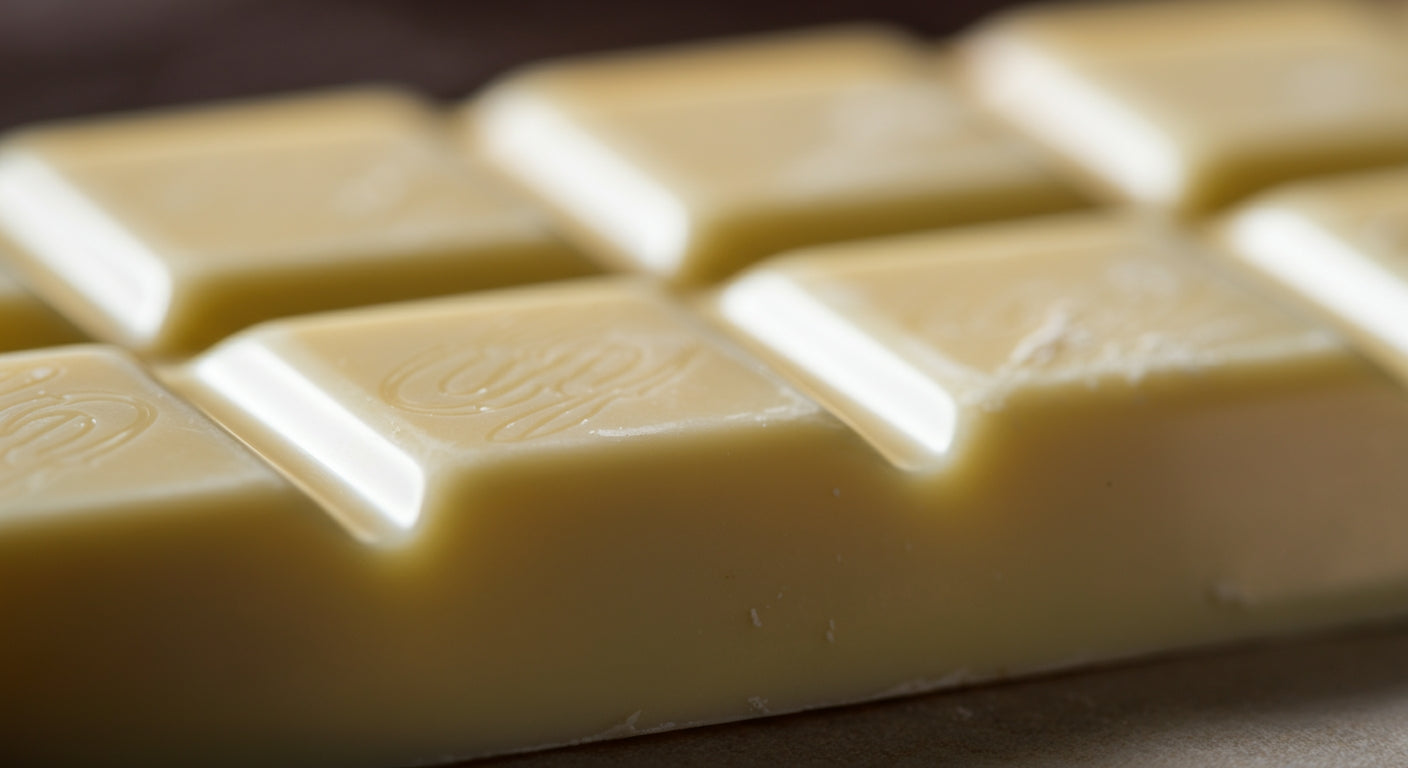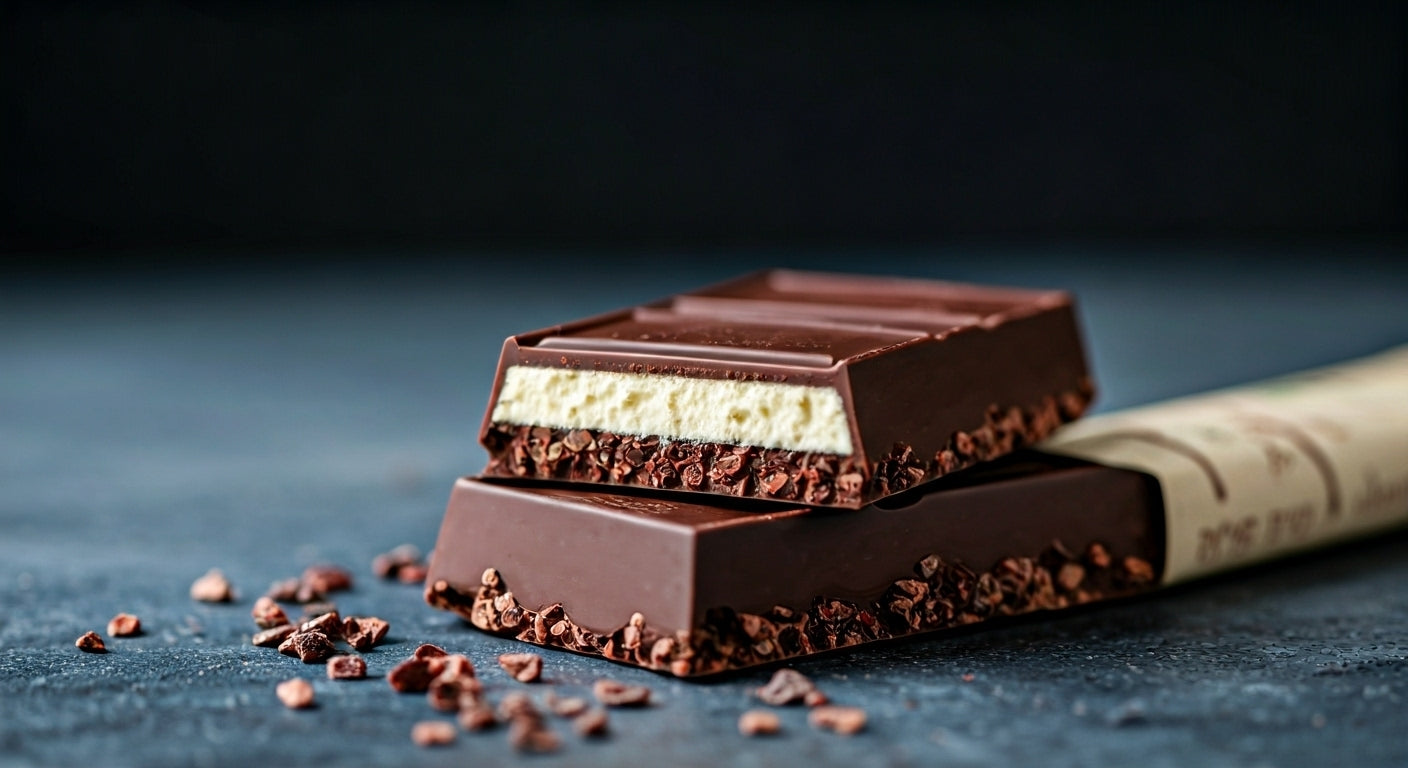
How to Make Vegan Chocolate: Your Complete Plant-Based Chocolate Guide
Ready to create delicious, ethical chocolate that aligns with your values? Making vegan chocolate involves using plant-based ingredients like cacao butter, cacao powder, and natural sweeteners while avoiding all animal products including dairy, honey, and refined sugars processed with bone char. With the right ingredients and techniques, you can create professional-quality vegan chocolate at home that rivals any commercial version. Let's explore everything from basic dark chocolate to complex milk and white chocolate alternatives.
Understanding Vegan Chocolate Fundamentals
What Makes Chocolate Vegan vs. Non-Vegan
Vegan Chocolate Contains Only:
- Cacao-based ingredients (beans, powder, butter)
- Plant-based sweeteners (coconut sugar, maple syrup, agave)
- Natural flavorings (vanilla beans, spices)
- Plant milk powders (for milk chocolate alternatives)
- Nuts and seeds (for texture and flavor)
Non-Vegan Ingredients to Avoid:
- Milk solids, milk powder, or dairy of any kind
- Honey (animal-derived sweetener)
- Refined white sugar (often processed with bone char)
- Some food colorings (carmine from insects)
- Certain emulsifiers (may be animal-derived)
Our organic cacao butter and premium cacao powder provide the perfect foundation for creating exceptional vegan chocolate with authentic flavor and texture.

Essential Equipment for Vegan Chocolate Making
Basic Home Setup
Minimum Required Tools:
- Double boiler or microwave-safe bowl (for melting)
- Digital thermometer (for temperature control)
- Silicone chocolate molds (various shapes and sizes)
- Fine-mesh strainer (for smooth texture)
- Whisk or wooden spoon (for mixing)
- Kitchen scale (for precise measurements)
Upgraded Equipment:
- High-speed blender (for ultra-smooth textures)
- Food processor (for grinding nuts and making pastes)
- Chocolate tempering machine (for professional results)
- Granite mortar and pestle (for spice grinding)
Temperature Control Essentials
Critical Temperature Ranges:
- Raw chocolate: Keep below 118°F (48°C)
- Cacao butter melting: 95-100°F (35-38°C)
- Working temperature: 88-90°F (31-32°C)
- Setting temperature: Refrigerate at 35-40°F (2-4°C)
Why Temperature Matters:
- Preserves nutrients in raw preparations
- Prevents burning and bitter flavors
- Ensures proper setting and texture
- Creates stable chocolate that doesn't bloom
Basic Vegan Dark Chocolate Recipe
Ingredients (Makes about 8 oz)
Core Components:
- 1/2 cup organic cacao butter, chopped
- 1/2 cup cacao powder
- 1/4 cup organic coconut sugar (powdered)
- 1 teaspoon vanilla extract
- Pinch of sea salt
Optional Additions:
- 1 tablespoon coconut oil (for extra smoothness)
- 1-2 tablespoons maple syrup (for added sweetness)
- Spices (cinnamon, cardamom, chili powder)
Step-by-Step Instructions
Step 1: Prepare Workspace
- Clean and dry all equipment thoroughly
- Set up double boiler with simmering water
- Have molds ready and at room temperature
- Measure all ingredients precisely
Step 2: Melt Cacao Butter
- Gently melt cacao butter in double boiler
- Monitor temperature, keeping below 100°F
- Stir occasionally until completely liquid
- Remove from heat when fully melted
Step 3: Create Chocolate Base
- Sift cacao powder to remove lumps
- Gradually whisk cacao powder into melted butter
- Add powdered coconut sugar slowly
- Mix until completely smooth
Step 4: Add Flavorings
- Stir in vanilla extract and salt
- Add any optional spices or sweeteners
- Taste and adjust sweetness as needed
- Strain mixture if any lumps remain
Step 5: Mold and Set
- Pour chocolate into prepared molds
- Tap molds to release air bubbles
- Refrigerate for 30-60 minutes until firm
- Unmold carefully when completely set
Vegan Milk Chocolate Alternative
Plant-Based Milk Chocolate Ingredients
Base Recipe:
- 1/2 cup cacao butter, melted
- 1/4 cup cacao powder
- 1/4 cup coconut milk powder
- 1/3 cup powdered coconut sugar
- 2 tablespoons cashew butter (for creaminess)
- 1 teaspoon vanilla extract
- 1/4 teaspoon sea salt
Creating Creamy Texture
Milk Powder Options:
- Coconut milk powder: Rich, tropical flavor
- Cashew cream powder: Ultra-smooth texture
- Oat milk powder: Mild, neutral taste
- Rice milk powder: Light, clean flavor
Technique for Smoothness:
- Blend thoroughly: Use high-speed blender if available
- Strain mixture: Remove any remaining particles
- Temperature control: Maintain optimal working temperature
- Proper ratios: Balance fats, solids, and sweeteners
Advanced Milk Chocolate Variations
Hazelnut Milk: Add 2 tablespoons hazelnut butter Vanilla Bean: Use real vanilla bean paste Salted Caramel: Include date caramel and sea salt Spiced Milk: Add cardamom, cinnamon, and nutmeg
Vegan White Chocolate Creation
White Chocolate Base Recipe
Ingredients:
- 2/3 cup cacao butter, melted
- 1/3 cup coconut milk powder
- 1/4 cup powdered coconut sugar
- 1 tablespoon vanilla extract
- 1/4 teaspoon sea salt
Achieving White Chocolate Characteristics
Color Considerations:
- Pure white: Use refined coconut products
- Ivory tint: Natural coconut gives slight color
- Avoid browning: Keep temperatures very low
- Quality matters: Premium cacao butter provides best color
Texture Optimization:
- Powder everything: Ensure all dry ingredients are powdered
- Gradual incorporation: Add solids slowly to prevent lumps
- Extended mixing: Blend longer for ultra-smooth texture
- Quality testing: Check for grittiness before molding
Flavored White Chocolate Options
Lemon White: Add lemon zest and extract Rose White: Include food-grade rose petals Lavender White: Use culinary lavender Coconut White: Extra coconut cream and flakes

Sweetener Options for Vegan Chocolate
Natural Sweetener Comparison
Coconut Sugar:
- Flavor: Mild caramel notes
- Texture: Dissolves well when powdered
- Glycemic index: Lower than refined sugar
- Best for: All chocolate types
Maple Syrup:
- Flavor: Rich, complex sweetness
- Texture: Adds moisture, may soften chocolate
- Processing: Grade A for mildest flavor
- Best for: Raw chocolates, ganaches
Date Paste:
- Flavor: Natural fruit sweetness
- Texture: Requires thorough blending
- Nutrition: Adds fiber and minerals
- Best for: Raw energy bars, fruit-flavored chocolates
Stevia/Monk Fruit:
- Flavor: Very sweet, potential aftertaste
- Texture: Powdered forms work best
- Usage: Small amounts needed
- Best for: Sugar-free versions, diabetic-friendly options
Sweetener Processing Tips
Powdering Granulated Sweeteners:
- Use coffee grinder or high-speed blender
- Sift to ensure fine texture
- Store in airtight containers
- Make fresh batches for best results
Liquid Sweetener Adjustments:
- Reduce other liquids when using syrups
- Add binding agents if needed for structure
- Adjust cacao butter ratio to maintain consistency
- Test small batches before scaling up
Advanced Techniques and Professional Tips
Chocolate Tempering for Vegans
Why Temper Chocolate:
- Better snap and shine: Professional appearance
- Stable at room temperature: Longer shelf life
- Prevents bloom: White spots on surface
- Improved mouthfeel: Melts cleanly on tongue
Simplified Tempering Method:
- Heat phase: Warm chocolate to 88-90°F
- Cool phase: Lower to 84-86°F while stirring
- Working phase: Maintain 86-88°F during use
- Test: Drop should set within 3 minutes
Texture Enhancement Techniques
Creating Smoothness:
- High-speed blending: Eliminates grittiness
- Extended mixing: Develops proper texture
- Quality ingredients: Premium cacao products make a difference
- Proper ratios: Balance fats and solids
Adding Inclusions:
- Nuts and seeds: Toast before adding for better flavor
- Dried fruits: Ensure completely dry to prevent bloom
- Spices: Bloom in warm cacao butter for better distribution
- Cacao nibs: Add texture and intense chocolate flavor
Professional Quality Control
Taste Testing:
- Balance: Sweet, bitter, and flavor notes
- Texture: Smooth melting, no grittiness
- Temperature: Test at serving temperature
- Adjustments: Modify ratios based on results
Visual Assessment:
- Color: Consistent throughout batch
- Surface: Smooth, glossy finish
- Structure: Clean snap when broken
- Stability: No bloom or separation

Storage and Shelf Life
Optimal Storage Conditions
Environmental Factors:
- Temperature: 60-68°F (15-20°C) consistently
- Humidity: Below 50% to prevent bloom
- Light: Dark storage to prevent degradation
- Air: Airtight containers to minimize oxidation
Packaging Options:
- Food-safe containers: Glass or BPA-free plastic
- Wrapping materials: Parchment paper or food-grade foil
- Portion control: Individual wrapping for freshness
- Labeling: Date and contents for rotation
Shelf Life Expectations
Homemade Vegan Chocolate:
- Dark chocolate: 3-6 months properly stored
- Milk alternatives: 2-4 months (plant milk powders)
- White alternatives: 2-3 months (more sensitive ingredients)
- Raw preparations: 1-3 months (no preservatives)
Signs of Deterioration:
- White bloom: Fat or sugar crystallization
- Off odors: Rancidity or contamination
- Texture changes: Softening or hardening
- Flavor loss: Reduced chocolate intensity
Troubleshooting Common Issues
Problem: Chocolate Won't Set
Possible Causes:
- Insufficient cacao butter: Add more solid fat
- Temperature too warm: Ensure proper cooling
- Incorrect ratios: Adjust fat-to-solids balance
- Quality issues: Use premium cacao butter
Problem: Grainy or Gritty Texture
Solutions:
- Better blending: Use high-speed equipment
- Sift ingredients: Remove lumps before mixing
- Proper melting: Avoid overheating
- Quality ingredients: Choose finely ground powders
Problem: Too Sweet or Bitter
Adjustments:
- Gradual changes: Small adjustments at a time
- Taste testing: Check frequently during process
- Balance notes: Add salt to enhance sweetness perception
- Documentation: Record successful ratios
Problem: Chocolate Blooms
Prevention:
- Temperature stability: Avoid fluctuations
- Proper storage: Control humidity and heat
- Quality control: Use fresh, dry ingredients
- Tempering: Follow proper tempering procedures
Recipe Variations and Flavor Combinations
Superfood Additions
Adaptogenic Chocolates:
- Ashwagandha: Stress-relief properties
- Reishi mushroom: Immune system support
- Maca powder: Energy and hormonal balance
- Spirulina: Nutrient density boost
Antioxidant Boosters:
- Goji berries: Vitamin C and antioxidants
- Acai powder: High antioxidant content
- Pomegranate powder: Anti-inflammatory compounds
- Turmeric: Golden milk chocolate variation
International Flavor Inspirations
Mexican Chocolate: Cinnamon, vanilla, chili powder Chai Spiced: Cardamom, ginger, cloves, black pepper Matcha White: Green tea powder in white chocolate base Turkish Delight: Rose water and pistachios
Seasonal Variations
Winter Spices: Nutmeg, allspice, orange zest Spring Florals: Lavender, elderflower, lemon Summer Fruits: Freeze-dried berries, tropical flavors Autumn Harvest: Pumpkin spice, maple, pecans
Cost Analysis and Batch Scaling
Economic Considerations
Initial Investment:
- Equipment: $50-200 for basic setup
- Ingredients: $30-50 for multiple batches
- Molds: $20-40 for variety of shapes
- Quality materials: Premium cacao products for best results
Cost Per Batch:
- Basic dark chocolate: $8-12 per pound
- Milk alternatives: $10-15 per pound
- White alternatives: $12-18 per pound
- Specialty flavors: $15-25 per pound
Scaling Production
Small Batches (1-2 lbs):
- Easier temperature control
- Less waste if errors occur
- Better for experimentation
- Manageable equipment requirements
Larger Batches (5+ lbs):
- Better cost efficiency
- Requires better equipment
- More storage planning needed
- Commercial considerations
Safety and Food Handling
Hygiene Protocols
Workspace Preparation:
- Sanitize all surfaces and equipment
- Wash hands thoroughly before handling ingredients
- Use clean utensils for each ingredient
- Avoid cross-contamination with allergens
Ingredient Safety:
- Check expiration dates on all components
- Store properly to prevent spoilage
- Source quality ingredients from reputable suppliers
- Monitor temperatures throughout process
Allergen Considerations
Common Allergens in Vegan Chocolate:
- Tree nuts: Almonds, cashews, hazelnuts
- Coconut: Technically classified as tree nut
- Soy: In lecithin or plant milk powders
- Sesame: In tahini-based recipes
Cross-Contamination Prevention:
- Dedicated equipment for allergen-free batches
- Clear labeling of finished products
- Separate storage for different allergen categories
- Thorough cleaning between batches
Frequently Asked Questions
Can I make vegan chocolate without cacao butter?
While possible using coconut oil or other plant fats, cacao butter provides the best texture, melting properties, and authentic chocolate characteristics. Alternatives may result in softer texture or different melting points.
How do I make vegan chocolate as smooth as commercial versions?
Use high-speed blending equipment, sift all dry ingredients, maintain proper temperatures, and choose premium quality cacao powder. Commercial chocolate also undergoes conching for 24+ hours, which home methods can't replicate.
What's the best plant milk powder for vegan milk chocolate?
Coconut milk powder provides the richest, creamiest texture most similar to dairy milk chocolate. Cashew cream powder offers ultra-smooth results, while oat milk powder gives a neutral flavor that lets chocolate shine through.
How long does homemade vegan chocolate last?
Properly stored homemade vegan chocolate lasts 2-6 months depending on ingredients used. Dark chocolate keeps longest, while versions with plant milk powders have shorter shelf lives. Store in cool, dry, dark conditions for maximum longevity.
Can I sell homemade vegan chocolate?
Commercial sale requires meeting food safety regulations, proper licensing, facility inspections, and insurance. Home production is generally limited to personal use unless you meet commercial food production standards in your jurisdiction.
Why does my vegan chocolate have white spots (bloom)?
Bloom occurs from temperature fluctuations (fat bloom) or humidity exposure (sugar bloom). Prevent by storing at consistent temperatures, controlling humidity, and using proper tempering techniques when making chocolate.
Quick Recipe Guide (Featured Snippet Optimized)
To make vegan chocolate: Melt 1/2 cup cacao butter, whisk in 1/2 cup cacao powder and 1/4 cup powdered coconut sugar, add vanilla and salt, pour into molds, refrigerate until set. Use plant milk powders for milk chocolate alternatives. Keep temperatures below 100°F. Avoid dairy, honey, and bone char-processed sugars.
Master the Art of Ethical Chocolate Making
Creating exceptional vegan chocolate at home connects you directly to the ancient art of chocolate making while honoring your ethical values. With quality ingredients, proper techniques, and patience, you can produce chocolates that rival any commercial version while knowing exactly what goes into every bite.
Our premium cacao butter and organic cacao powder provide the foundation for creating extraordinary vegan chocolates. Sourced directly from Peru's finest cacao farms and processed using methods that preserve maximum flavor and nutritional value, these ingredients ensure your homemade chocolates achieve professional quality.
Whether you're creating simple dark chocolate bars or complex milk and white chocolate alternatives, understanding the fundamentals of vegan chocolate making opens endless possibilities for ethical indulgence. Explore our complete collection of ethically-sourced cacao products to support your chocolate-making journey.
Learn more about chocolate craftsmanship through our comprehensive blog, where we share traditional techniques, modern innovations, and the artistry behind creating exceptional plant-based chocolates. Your journey into conscious chocolate creation begins with understanding that the best chocolates come from the best ingredients, prepared with care, knowledge, and respect for the ancient wisdom of cacao.

Claire Bennett
I'm Claire, a chocolate lover and artisan based in a small town where I run a tiny home kitchen dedicated to exploring everything chocolate. From single-origin dark bars to creamy ganache and handmade truffles, I find joy in working with all types of chocolate. I believe chocolate has a story, and I love bringing that story to life through humble, heartfelt creations.



Leave a comment
This site is protected by hCaptcha and the hCaptcha Privacy Policy and Terms of Service apply.